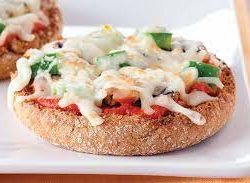Mini Pizza

fuente de imagen/receta: cookingmatters.org
- 1 pimenton verde o rojo
- 8 onzas de champinones pequenos
- 1 tomate grande
- 4 onzas de queso mozzarella
- 6 muffins ingleses de trigo integral
- 1 cucharada de aceite de canola
- 1/2 cucharadita de oregano seco
- 1/2 cucharadita de albahaca seca
- 1 8oz lata de salsa de tomate, sin sal anadida
-
1. Precaliente el horno a 450 F.
2. Lave el pimenton, los champinoes y el tomate.
3. Saquele el centro al pimenton y cortelo entajadas delgadas. Corte los champinones en rodajitas. Saquele el centro al tomate y piquelo en pedacitos de 1/4 de pulgada.
4. Ralle el queso en un tazon pequeno.
5. Abra los muffins por la mitad. Coloquelos en bandeja para hornear. Hornee hasta que los bordes esten ligerament dorados, unos 10 minutos. Prepare la salsa mientras se hornean los muffins.
6. Caliente el aceite en una sarten grande a temperature media. Eche los pimentones y los champinones. Cocine por 5 minutos. Si en necesario, use el colador para escurrir las verduras.
7. Pase las verduras a un tazon mediano. Anada los tomates. Revuelva.
8. Eche los condimentos en la salsa de tomate. Haga esto directamente en la lata.
9. Cuando los muffins esten ligeramente dorados, con una cuchara eche 1 cucharada de salsa sobre cada mitad de muffin. Cubralos uniformemente.
10. Coloque una capa de verduras sobre la salsa. Si va a usar el salchichon, ponga una tajada en cada muffin. Espolvoree con el queso rallado.
11. Hornee los muffins hasta que el queso este derretido y haga burbujas, de 6 a 8 minutos.
12. Deje que las pizzas se enfrien por 3 minutos antes de servir.
Recipe Video
Ingredientes opcionales: 12 tajadas de salchichon de pavo




